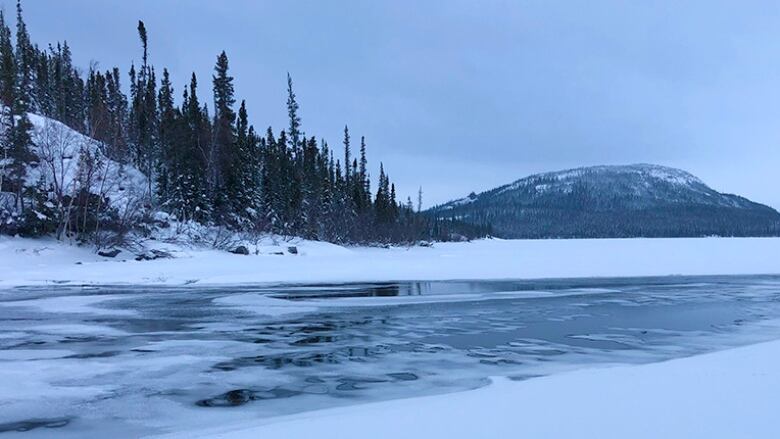Lifesaving tech installed at Canada's deepest lake by Wilfrid Laurier researchers
Great Slave Lake is taking longer and longer to freeze, raising safety concerns

A group of researchers from Wilfrid Laurier Universityis working with a Dene First Nation in the Northwest Territories ona system of remote sensors so that people can know how thick the ice is before they go out.
At more than 600 metres, the Northwest Territories' Great Slave Lake is Canada's deepest lake.
Italso serves asa vital lifeline for many living in the arctic region that surrounds the lake. Especially during the colder months where traveling across the lake is essential for the survival of communitieslikeutsl K', that can only be accessed by air, boat or ice.
But as the climate continues to warm, it's gotten harder to predict when the ice will freeze.
"In the last 10 years it's taking longer and longer for our big lake to freeze, and we use that lake quite extensively in the winter months," saidIris Catholique, in a news release from Wiflrid Laurier University. CatholiquemanagesThaidene NnNational Park Reserve, homeland of theutsl K' Dene First Nation.

"Waiting longer and longer for the lake to freeze impedes our ability to access our traditional hunting grounds and provide for our people." added Catholique.
At timesit has had tragic consequences: in 2019 three snowmobilers went missing. It's believed they died after fallingthrough the ice on Great Slave Lake.
The growing uncertainty surrounding the safety of the ice prompted Catholiqueand her colleagues to reach out to WLUassistantprofessor and Canada Research Chair in Remote Sensing of Environmental Change, Homa KheyrollahPour.

"The ice is a big part of the community of transportation as well as hunting in their traditional way of living. It's a huge, huge part of their culture." said Kheyrollah Pour toldCBC News.
She and her team have been studying cold region water systems and their responses to climate changeby installing sensors on lakes in order to collect real-time measurements of ice thickness, snow depth, as well as air and water temperatures.
Similar sensors have been installed around other lakes in the Arctic.
Theresearch is part of the territorial government's Cumulative Impact Monitoring Program, which collects information from the environment to guide decision-making.
How do the sensors work?
The sensors,calledSnow and Ice Mass Balance Apparatus orSIMBAS, are small inexpensive devices that were installed in two locations on Great Slave Lake at the beginning of the year.
Every 15 minutes, the sensors collect data detailing the thickness of ice, snow accumulation and water temperature which is then used to let the community know whether or not it's safe to travel across the lake.

"The sensors are smart." said Kheyrollah Pour. "There is a temperature chain that tells us the measurement of ice and snow...and theyhave a telemetry in radium."
For now, community members have been getting updates by calling or texting Kheyrollah Pour when they want the latest readings, she said.
"It's fascinating because I'm sitting in my office and I get a text... 'How deep is the ice? How thick isthe ice?'I can actually tell them, right just give me a minute."
Her team is in the process of building a website and map interface thatpeople can use to get daily updates on lakeconditions.
Travelling on broken ice
As climate temperatures continue to warm, the conditions of Arctic sea ice have been getting more and more dangerous.
Robert Kuptana, an elder and long-time hunter and trapperfromUlukhaktok, N.W.Tsaidfor the past few years there has been a lot of what he calls rough ice.
"It has to do with the temperature," he explained. If it doesn't get cold enough, the ice isn't strong when wind and ocean currents push against it, he said. That can cause the ice to break and for ice fragments to jumble up across a wide area without any order, making it difficult for snowmobiles to navigate.

Kuptana, 80, also pointed out that"you don't see thick ice anymore."
But Mark Serreze, director of the National Snow and Ice Data Center(NSIDC) in Boulder, Colorado,says the volume of the ice is agoodindicator of the healthof the ice.
And while Arctic sea icegrew until March 6 this year, covering 14.62 million square kilometres, Serreze says the health of the Arctic ice cover is "not very good."
"If you look at the Arctic Ocean, it used to be you'd find some ice in there that was like 10 years old It would tend to get quite thick, old and thick. But most of that's gone."
And it's unlikely togrow back in the future, Serreze says.
"Partly it's melted away, partly it's gotten flushed out of the Arctic Ocean into the North Atlantic where it would melt. But just about all that's gone. It doesn't look like we're going to get it back. It's just too warm to get it back".
With files from Liny Lamberink












_(720p).jpg)


 OFFICIAL HD MUSIC VIDEO.jpg)
.jpg)



























































































